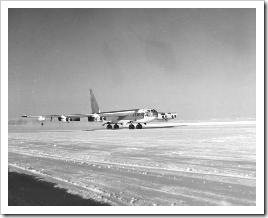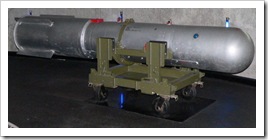The US May Have Lost A Nuclear Weapon in 1968 According to BBC. [Ignore The Green Glowing Polar Bear.]
 According to the BBC, the United States abandoned a nuclear weapon beneath the ice in northern Greenland following a crash in 1968.
According to the BBC, the United States abandoned a nuclear weapon beneath the ice in northern Greenland following a crash in 1968.
Thule Air Base was built in the early 1950s as an important strategic position over the Soviet Union, and was established as a Strategic Air Command (SAC) installation. The Pentagon believed that the Russians would take out the base as a prelude to a nuclear strike against the US and so in 1960 began flying "Chrome Dome" missions. Nuclear-armed B52 bombers continuously circled over Thule - and could head straight to Moscow if they were ordered or they could verify if a Soviet attack occurred at the base via UHF.
BROKEN ARROW
On January 21, 1968 a B-52G Stratofortress that was in a holding pattern over Thule, carrying four B28 thermonuclear weapons with a reported yield of 1.1 megaton each, caught on fire in the cockpit. The fire, which was a result of a malfunctioning cabin heater caused an emergency to be declared. The plane crashed into the ice in Greenland. According to direct witnesses, all that one could find were smoldering pieces of metal on the blackened ice.
OPERATION CRESTED ICE
Experts reported that the weapon consisted of plutonium, lithium-6-deuteride, and tritium, while the trigger is a package of high explosive employing a forty-point detonation system.
Over the next months, thousands of tiny pieces of debris that had scattered over the frozen bay, as well as some 500 million gallons of ice, some of it containing radioactive debris, was collected.
There was only one small problem; while the high explosives surrounding the four nuclear weapons had detonated, the actual nuclear device didn't. The Pentagon maintained that all four weapons had been "destroyed".
THE BBC'S FINDINGS
 To the left is B28FI nuclear bomb, that was used only by SAC-B52s.
To the left is B28FI nuclear bomb, that was used only by SAC-B52s.
According to the BBC, the "destroyed" may be technically true, since the bombs were no longer complete, but declassified documents obtained by the BBC under the US Freedom of Information Act, revealed a different story, and has been confirmed by individuals involved in the clean-up and those who have had access to details since, said the BBC. According to the BBC,
The documents make clear that within weeks of the incident, investigators pieced together the fragments realized that only three of the weapons could be accounted for.
Even by the end of January, one document talks of a blackened section of ice which had re-frozen with shroud lines from a weapon parachute. "Speculate something melted through ice such as burning primary or secondary," the document reads, the primary or secondary referring to parts of the weapon.
By April, a decision had been taken to send a Star II submarine to the base to look for the lost bomb, which had the serial number 78252.
But the real purpose of this search was deliberately hidden from Danish officials.
One document from July reads: "Fact that this operation includes search for object or missing weapon part is to be treated as confidential NOFORN", the last word meaning not to be disclosed to any foreign country. ...
But the underwater search was beset by technical problems and, as winter encroached and the ice began to freeze over, the documents recount something approaching panic setting in.
As well as the fact they contained uranium and plutonium, the abandoned weapons parts were highly sensitive because of the way in which the design, shape and amount of uranium revealed classified elements of nuclear warhead design.
But eventually, the search was abandoned. Diagrams and notes included in the declassified documents make clear it was not possible to search the entire area where debris from the crash had spread.
The BBC tracked down a few people who were familiar with the incident. One of them was William H. Chambers, a former nuclear weapons designer at the Los Alamos nuclear laboratory, who once ran a team dealing with accidents, including the Thule crash.
"There was disappointment in what you might call a failure to return all of the components," he told the BBC, explaining the logic behind the decision to abandon the search.
"It would be very difficult for anyone else to recover classified pieces if we couldn't find them."
The view was that no-one else would be able covertly to acquire the sensitive pieces and that the radioactive material would dissolve in such a large body of water, making it harmless.
Other officials who have seen classified files on the accident confirmed the abandonment of a weapon.
The Pentagon declined to comment on the investigation, referring back to previous official studies of the incident.
TODAY
Today the 821st Air Base Group is based at the Thule Air Base. It contains Detachment 3, 22ND Space Operations Squadron, the largest and northernmost unit of eight worldwide satellite tracking stations in the Air Force Satellite Control Network (AFSCN). It also contains the 12th Space Warning Squadron which operates the Ballistic Missile Early Warning System. There are nearly 600 troops and civilians posted at Thule. If there are green glowing polar bears walking around, nobody is talking about it.
ADDITIONAL SOURCES:


0 Responses to "The US May Have Lost A Nuclear Weapon in 1968 According to BBC. [Ignore The Green Glowing Polar Bear.]"
Post a Comment